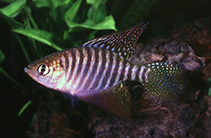| Family: |
Rivulidae (Rivulines), subfamily: Cynolebiinae |
| Max. size: |
5.13 cm SL (male/unsexed) |
| Environment: |
benthopelagic; freshwater |
| Distribution: |
South America: São Francisco River basin, Brazil. |
| Diagnosis: |
Dorsal soft rays (total): 15-25; Anal soft rays: 18-24; Vertebrae: 29-31. Caudal peduncle of female with black spots. Male's anal fin with gray to black distal stripe, iridescent dots restricted to posterior portion of the fin, anterior part pink and posterior yellow; basihyal broad, 70-95% in length; and, second pharyngobranchial teeth,5-10. Dorsal-fin rays 22-25 in male, 15-19 in female; anal-fin rays 22-24 in male, 18-22 in female; caudal-fin rays 23-25, caudal fin subtruncate in male, rounded in female. Males possess pronounced pectoral-fin contact organs and elongated brilliant spots on anterobasal part of dorsal fin (Ref. 49550). |
| Biology: |
Occurs in seasonal pools (Ref. 89836). |
| IUCN Red List Status: |
Least Concern (LC); Date assessed: 07 November 2018 Ref. (130435)
|
| Threat to humans: |
harmless |
Source and more info: www.fishbase.org. For personal, classroom, and other internal use only. Not for publication.
